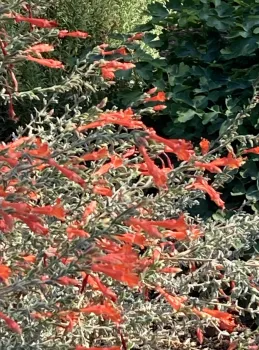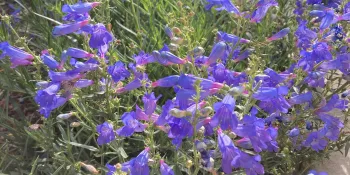Article and photos by Joy Sakai -

Have you noticed that most native plant gardeners avoid deadheading during the summer and fall? That's because native bees are using the flowers for nectar and pollen, and birds feed on the seeds. For another thing, nobody wants to go out and garden in 100° plus weather. That’s my excuse for why our native garden starts to look a little ratty in the fall.
Lots of native plants need to be pruned in late fall or early winter, but I'm always torn over removing useful dead flowers and pruning the bright and full blooms of the native fuchsia plants while our Anna’s hummingbirds are still enjoying them. So, I procrastinate. Nevertheless, our garden feels like more work now that we are in our seventies so we have to start somewhere to get it all done before the weather turns miserable. The benefits of fall and winter pruning are on full display in the spring. Pruning brings blooming.
Although these plants don’t need weekly care, natives are not completely maintenance-free. This is especially true if you want them to look their best all year long. With native gardening, and frankly any no-lawn gardening, maintenance happens in short stretches that are spread around the calendar year. However, most of the intensive care happens from late fall to early winter.
Certain shrubs, such as California fuchsia (Epilobium canum), California goldenrod (Solidago velutina ssp. Californica), and hummingbird sage (Salvia spathacea), spread via rhizomes. So, part of the late fall to winter work is removing some of the plants that spread into areas where they shouldn't be. That can be a big job, and we usually start around this time and do a bit at a time. You might wonder why, if they spread so much, we keep them. The answer lies in their amazing scent, their gorgeous flowers, and the native bees, butterflies, and birds that at one time or another are all over them.
This is also a good time to lightly prune to remove deadwood and shape plants that are more sensitive to pruning, including some native sages. Ceanothus and Manzanita subspecies (Arctostaphylos manzanita) should not be pruned once the rains start because they are susceptible to fungal pathogens.

Mountain coyote mint (Monardella odoratissima) should be pruned to remove about one-third of its volume, according to Calscape, the California Native Plant Society website. The flowering stalks of Penstemon can be deadheaded now as well. At least in our yard, the native Verbena lilacina ‘de la mina’ has stopped flowering, and we will cut that back about six to eight inches.
Although people often plant natives for the right reasons (they need less water and care than a lawn, and support native fauna), they may not know where to go for guidance on how to manage their native plants after they are established and going strong. Look below for some of my favorite resources for advice on native plant care.
This time of year is also a great time for planting. Our heat has finally fizzled out, and right now the soil is fairly moist from recent rains. One caution about planting now is that although it is all right to walk on soil several days after rain, walking on it too soon can compact it, making it less healthy. We just planted a Vitex agnus-castus. This gem is on the list of updated Arboretum All-Stars recently published by U.C. Davis. After seeing it this summer covered with purple, spiky flowers, and butterflies and bees too numerous to count, I decided to give it a shot. Although it is not a native, it is heat and drought-tolerant, and looks like a great addition for all of the local pollinators.
Native California plant resources:
Rubin, G., Warren, L. (2016). The Drought Defying Garden. Timber Press, Portland, OR.
Frankie, G., Thorp, R,. et al, (2014). California Bees and Blooms: Heyday Press, Berkeley, CA.
California Native Plant Society - Calscape
